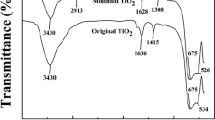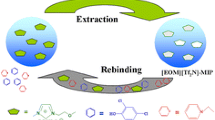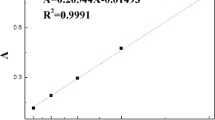Abstract
The adsorption of Th(IV) was studied using a novel dibenzoylmethane molecular imprinted polymers, which was prepared using acryloyl-β-cyclodextrin as a monomer on surface modified functional silica gel. X-ray photoelectron spectroscopy and FTIR were employed to confirm the reliability of the synthetic polymer. Scanning electron microscope was used to analyze the surface properties of the experimental materials. UV-spectrophotometer was employed to investigate the adsorption property and the concentration of Th(IV). Adsorption kinetics and adsorption isotherm were carried out. In pH 3.5, the adsorption equilibrium could reach a balance in 45 min, the resultant adsorbing capacity was 30.8 mg g−1, and the remove ratio of Th(IV) was 88.1 %.






Similar content being viewed by others
References
Shtangeeva I (2010) Uptake of uranium and thorium by native and cultivated plants. J Environ Radioact 101:458–463
Zoriy P, Ostapczuk P, Dederichs H, Höbig J, Lennartz R, Zoriy M (2010) Biomonitoring of environmental pollution by thorium and uranium in selected regions of the Republic of Kazakhstan. J Environ Radioact 101:414–420
Höllriegl V, Li WB, Leopold K, Gerstmann U, Oeh U (2010) Solubility of uranium and thorium from a healing earth in synthetic gut fluids: a case study for use in dose assessments. Sci Total Environ 408:5794–5800
Sato N, Kirishima A (2011) Separation of thorium and uranium by sulfide method. Energy Procedia 7:444–448
Harrison JJ, Zawadzki A, Chisari Rt, Wong HKY (2011) Separation and measurement of thorium, plutonium, americium, uranium and strontium in environmental matrices. J Environ Radioact 102:896–900
Masa JL, Villa M, Hurtadob S, García-Tenorio R (2012) Determination of trace element concentrations and stable lead, uranium and thorium isotope ratios by quadrupole-ICP-MS in NORM and NORM-polluted sample leachates. J Hazard Mater 205–206:198–207
Carretas JM, Cui JL, Santos IC, Cruz A, Maria L, Marcalo J (2012) Uranium(III,IV) and thorium(IV) pyrazolylmethane complexes: synthesis and structures. Inorg Chim Acta 385:53–57
Kutahyal C, Eral M (2010) Sorption studies of uranium and thorium on activated carbon prepared from olive stones: kinetic and thermodynamic aspects. J Nucl Mater 396:251–256
Amaral JCBS, Morais CA (2010) Thorium and uranium extraction from rare earth elements in monazite sulfuric acid liquor through solvent extraction. Miner Eng 23:498–503
Lindley BA, Parks GT (2012) Near-complete transuranic waste incineration in a thorium fuelled pressurised water reactor. Ann Nucl Energy 40:106–115
Permana S, Takaki N, Sekimoto H (2011) Breeding and void reactivity analysis on heavy metal closed-cycle water cooled thorium reactor. Ann Nucl Energy 38:337–347
Ozay O, Ekici S, Aktas N, Sahiner N (2011) P(4-vinyl pyridine) hydrogel use for the removal of UO2+ and Th4+ from aqueous environments. J Environ Manag 92:3121–3129
Komiyama M, Takeuchi T, Mukawa T, Asanuma H (2003) Molecular imprinting from fundamentals to applications. Wiley-VCH, Weinheim, pp 1–8
Schirmer C, Meisel H (2008) Molecularly imprinted polymers for the selective solid-phase extraction of chloramphenicol. Anal Bioanal Chem 392:223–229
Zaidi SA, Cheong WJ (2008) Robust open tubular layer of S-ketoprofen imprinted polymer for chiral LC separation. J Sep Sci 31:2962–2970
Liu JQ, Wulff G (2008) Functional mimicry of carboxypeptidase A by a combination of transition state stabilization and a defined orientation of catalytic moieties in molecularly imprinted polymers. J Am Chem Soc 130:8044–8054
Atta NF, Hamed MM, Abdel-Mageed AM (2010) Computational investigation and synthesis of a sol–gel imprinted material for sensing application of some biologically active molecules. Anal Chim Acta 667:63–70
Takeuchi T, Hishiya T (2008) Molecular imprinting of proteins emerging as a tool for protein recognition. Org Biomol Chem 6:2459–2467
Asanuma H, Akiyama T, Kajiya K, Hishiya T, Komiyama M (2001) Molecular imprinting of cyclodextrin in water for the recognition of nanometer-scaled guests. Anal Chim Acta 435:25–33
Venkatesh S, Saha J, Pass S, Byrne ME (2008) Transport and structural analysis of molecular imprinted hydrogels for controlled drug delivery. Eur J Pharm Biopharm 69:852–860
Esmaeili MA, Yazdanparast R (2010) Beta-cyclodextrin-bonded silica assists alkaline phosphatase and carbonic anhydrase refolding in a solid phase assisted refolding approach. Proc Biochem 45:239–246
Ng SM, Narayanaswamy R (2009) Molecularly imprinted β-cyclodextrin polymer as potential optical receptor for the detection of organic compound. Sens Actuators B 139:156–165
Zhang W, Qin L, He XW, Li WY, Zhang YK (2009) Novel surface modified molecularly imprinted polymer using acryloyl-β-cyclodextrin and acrylamide as monomers for selective recognition of lysozyme in aqueous solution. J Chromatogr A 1216:4560–4567
Zhang W, Qin L, Chen RR, He XW, Li WY, Zhang YK (2010) Protein imprinted polymer using acryloyl-β-cyclodextrin and acrylamide as monomers. Appl Surf Sci 256:3000–3005
Qin L, He XW, Li WY, Zhang YK (2008) Molecularly imprinted polymer prepared with bonded β-cyclodextrin and acrylamide on functionalized silica gel for selective recognition of tryptophan in aqueous media. J Chromatogr A 1187:94–102
Shamsipur M, Zargoosh K, Mizani F, Eshghi H, Rostami F (2010) A novel PVC-membrane optical sensor for highly sensitive and selective determination of UO2 2+ ion based on a recently synthesized benzo-substituted macrocyclic diamide and dibenzoylmethane. Spectrochim Acta A 77:319–323
Acknowledgments
This study was supported by National Natural Science Foundation of China (No. 20707008), Natural Science Foundation of Hunan Province (No. 07JJ5004) and Technology Department Foundation of Hunan Province (No. 2011GK3191).
Author information
Authors and Affiliations
Corresponding author
Rights and permissions
About this article
Cite this article
Ji, X.Z., Liu, H.J., Wang, L.L. et al. Study on adsorption of Th(IV) using surface modified dibenzoylmethane molecular imprinted polymer. J Radioanal Nucl Chem 295, 265–270 (2013). https://doi.org/10.1007/s10967-012-1979-4
Received:
Published:
Issue Date:
DOI: https://doi.org/10.1007/s10967-012-1979-4




